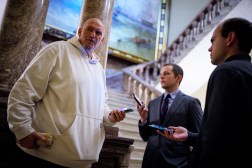From the White House to the General Services Administration and the Defense Department, the past year was about planning and building foundations. As a result, 2015 has all the makings of a year of action — with any luck.
Among the biggest foundational developments that will have a major impact on the year ahead is the recent signing of the Federal Information Technology Acquisition Reform Act, or FITARA. The new law is designed to streamline the government’s $80 billion in annual IT purchases. And while it also provides federal chief information officers with some new authorities and includes language that would require agencies to improve data center efficiency, many experts have criticized the bill for not going far enough. This year, it will be up to agencies to squeeze those efficiencies out of the new law.
Industry should also gear up for a year of agile development, as more agency CIOs are embracing the methodology for projects large and small. While many have embraced six-month development cycles, there has been talk of even more rapid development, according to some federal CIOs. One of the biggest agile development projects for 2015 will undoubtedly be the Department of Veterans Affairs’ commercial scheduling system, a $690 million contract that VA expects to award in January.
At the Defense Department, Acting CIO Terry Halvorsen has officially broken from the past with a new cloud procurement policy that effectively rescinds the Defense Information Systems Agency’s designation as the DOD enterprise cloud broker and gives the acquisition authority back to the services. DISA will remain an option for DOD organizations moving to the cloud and will also play a central role in security authorizations. Halvorsen’s cloud strategy promises big savings for DOD. But 2015 will be about making it happen.
GSA, HHS, Congress
Whereas 2014 was a big year for GSA IT in many ways — the launch of 18F and the announcement of Sonny Hashmi as its official CIO — 2015 could see its fair share of action as well.
GSA’s Office of Integrated Technology Services laid the foundation for its Common Acquisition Platform later in 2014, opening the first three of its hallways. The upcoming year will see plenty of developments on that front, as well as forward movement on a new Schedule 70 special item number for cloud procurement.
Also there’s buzz about a new GSA cybersecurity campus to be opened somewhere in the Washington, D.C., region. That plan, first announced in May, was approved with $35 million of funding by the recently passed Cromnibus bill.
Beginning in May 2015, the Department of Health and Human Services will kick off a pilot for the Digital Accountability and Transparency Act. HHS is the only agency in the federal government tasked with such, and FedScoop got the scoop on that story earlier in December.
The first quarter of 2015 will also see the close of the second round of Healthcare.gov. Things have gone relatively well so far, but considering the drama during the website’s first launch, both HHS and Republican lawmakers will be watching until the end of open enrollment on Feb. 15.
With the 114th Congress officially kicking off Jan. 3, it’s not immediately clear what the next session will bring the federal information technology world. However, if the action at the end of the 113th is any indication, things are looking good. In addition to FITARA, Congress passed several pieces of cybersecurity legislation. But Rep. Jason Chaffetz, R-Utah, has promised additional oversight efforts through the creation of an IT subcommittee within the House Oversight & Government Reform Committee.
On the Senate side, Sen. Tom Carper, D-Del., who served as chairman of the Homeland Security & Government Affairs Committee and will likely remain the panel’s senior Democrat next year, and has said that Postal Service reform legislation is among his top priorities for 2015. Congress will also need to tackle the 2015 reauthorization bill for the Federal Aviation Administration, which could include new provisions for unmanned aircraft systems and the Next Generation Air Transportation System, or NextGen.
White House
President Barack Obama may only have a short time left in his job, but the White House still has a lot of work to do in 2015. The president has yet to announce his pick to succeed Steven VanRoekel, who left the federal chief information officer post in late 2014 to go to the U.S. Agency for International Development to help in the Ebola fight. Lisa Schlosser, the deputy administrator for e-Government at Office of Management and Budget, is currently serving as acting CIO.
The president also called on Congress to move quickly to pass meaningful cybersecurity legislation, specifically an information sharing bill spearheaded by Sen. Dianne Feinstein, D-Calif. In early 2015, the administration could take more action on cybersecurity in response to North Korea’s alleged hacking of Sony.
The administration is also expected to release an executive order on drone privacy around the same time the FAA is scheduled to release the notice of proposed rule-making for small unmanned aircraft systems.
The Office of Personnel Management is fighting to revive a workforce deflated by years of sequestration and pay freezes. This coming year will be about using innovation to engage the federal workforce and give managers better tools to analyze the pain points with their employees.
And don’t forget 2014′s big discussions around the STEM skills gap and struggles to attract and retain millennials in the federal government. Those issues haven’t been resolved and will return bright and early in 2015.






